Financial Performance Report: OZ Minerals and Resolute Mining Analysis
VerifiedAdded on 2023/06/04
|12
|3692
|204
Report
AI Summary
This report provides a comprehensive financial analysis of OZ Minerals and Resolute Mining, two ASX-listed companies. It begins with a description of each company's background, core activities, and competitive advantages. The report then computes and analyzes various financial ratios, including short-term solvency, long-term solvency, asset utilization, and profitability ratios, using data from the companies' financial statements. Share price movements are graphed and compared against the All Ordinaries Index. The report also includes a share valuation using the constant dividend growth rate model. Based on the analysis, the report concludes with recommendations regarding the companies' financial performance, aimed at assisting decision-making for potential investors.
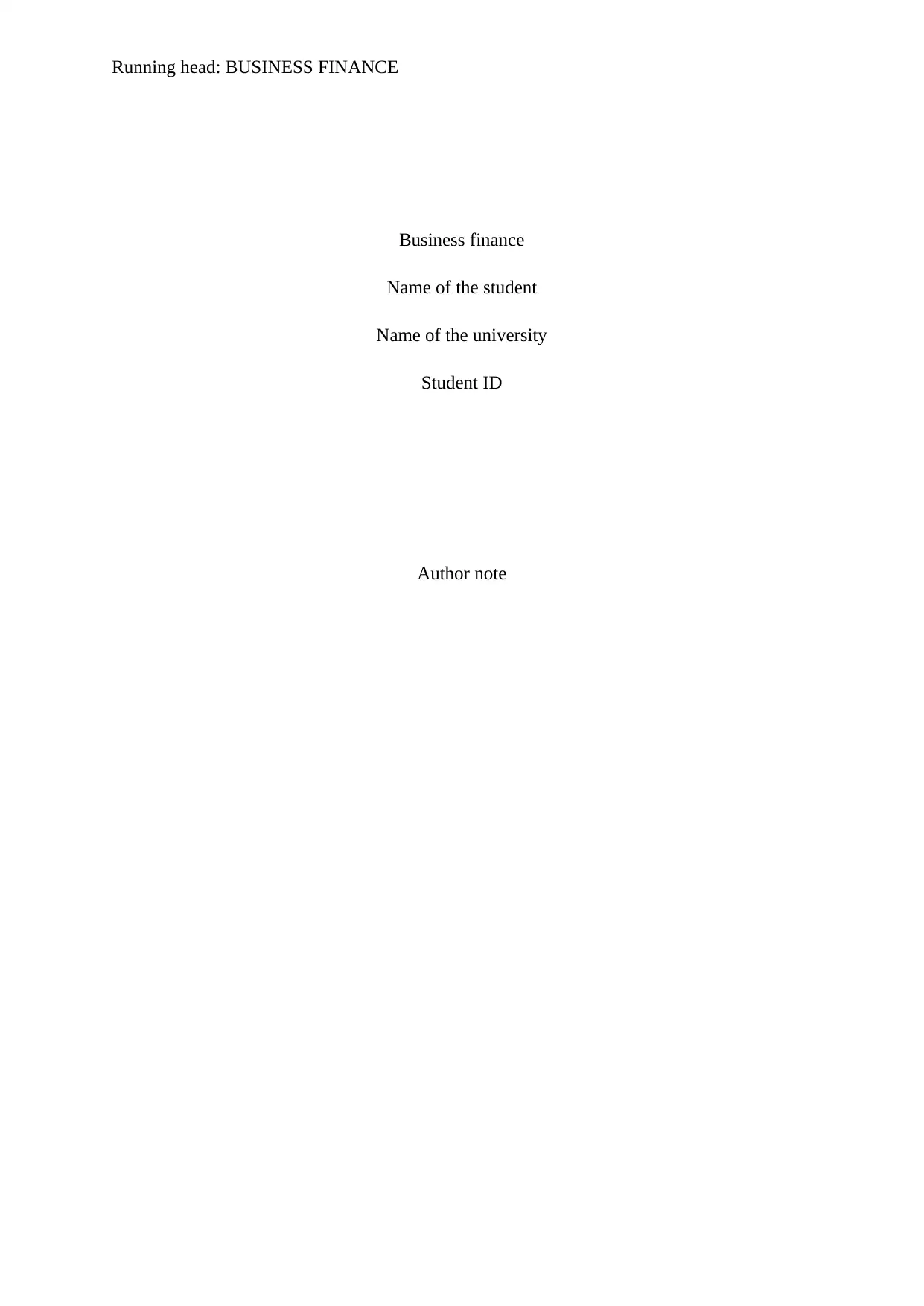
Running head: BUSINESS FINANCE
Business finance
Name of the student
Name of the university
Student ID
Author note
Business finance
Name of the student
Name of the university
Student ID
Author note
Paraphrase This Document
Need a fresh take? Get an instant paraphrase of this document with our AI Paraphraser
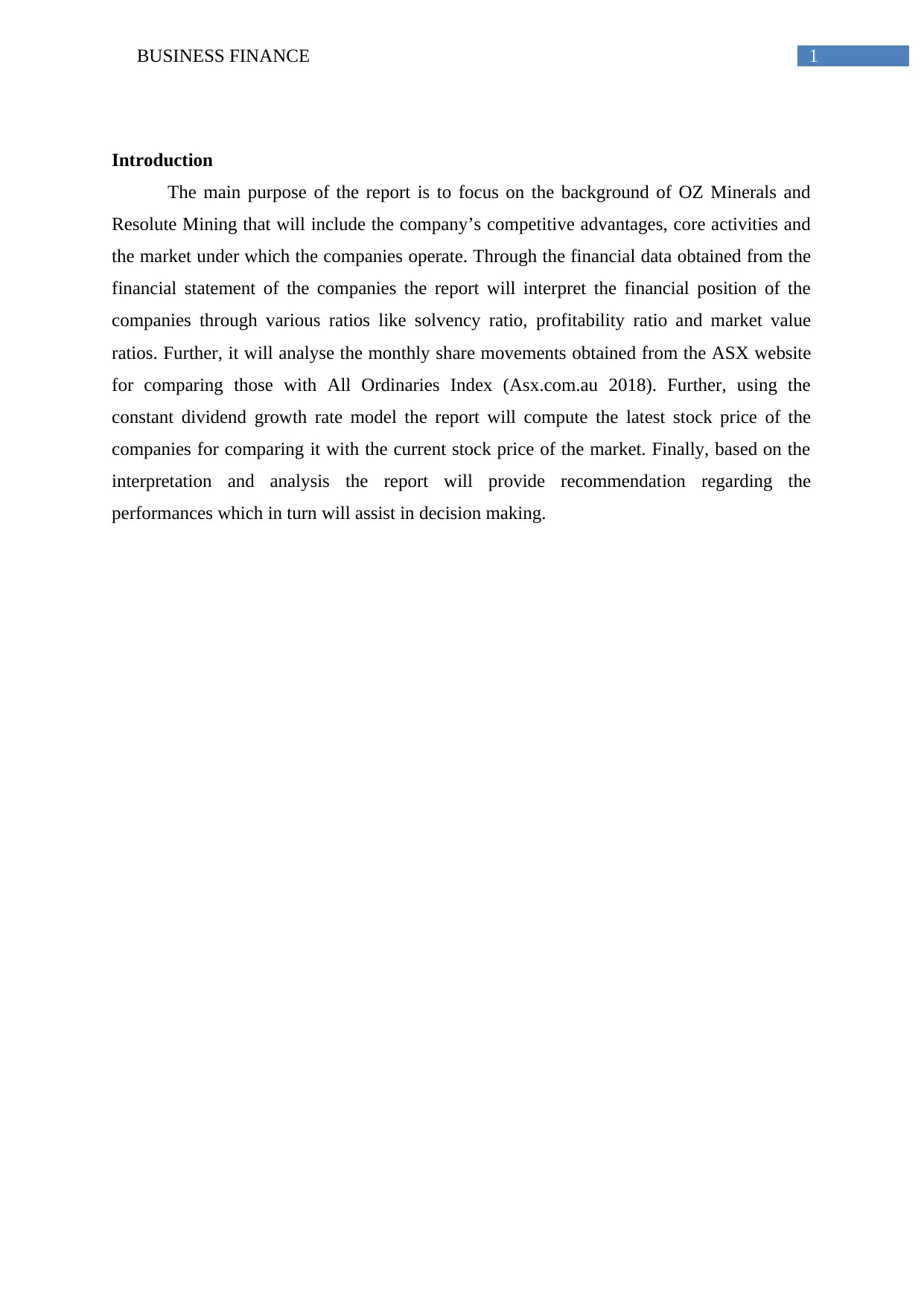
1BUSINESS FINANCE
Introduction
The main purpose of the report is to focus on the background of OZ Minerals and
Resolute Mining that will include the company’s competitive advantages, core activities and
the market under which the companies operate. Through the financial data obtained from the
financial statement of the companies the report will interpret the financial position of the
companies through various ratios like solvency ratio, profitability ratio and market value
ratios. Further, it will analyse the monthly share movements obtained from the ASX website
for comparing those with All Ordinaries Index (Asx.com.au 2018). Further, using the
constant dividend growth rate model the report will compute the latest stock price of the
companies for comparing it with the current stock price of the market. Finally, based on the
interpretation and analysis the report will provide recommendation regarding the
performances which in turn will assist in decision making.
Introduction
The main purpose of the report is to focus on the background of OZ Minerals and
Resolute Mining that will include the company’s competitive advantages, core activities and
the market under which the companies operate. Through the financial data obtained from the
financial statement of the companies the report will interpret the financial position of the
companies through various ratios like solvency ratio, profitability ratio and market value
ratios. Further, it will analyse the monthly share movements obtained from the ASX website
for comparing those with All Ordinaries Index (Asx.com.au 2018). Further, using the
constant dividend growth rate model the report will compute the latest stock price of the
companies for comparing it with the current stock price of the market. Finally, based on the
interpretation and analysis the report will provide recommendation regarding the
performances which in turn will assist in decision making.
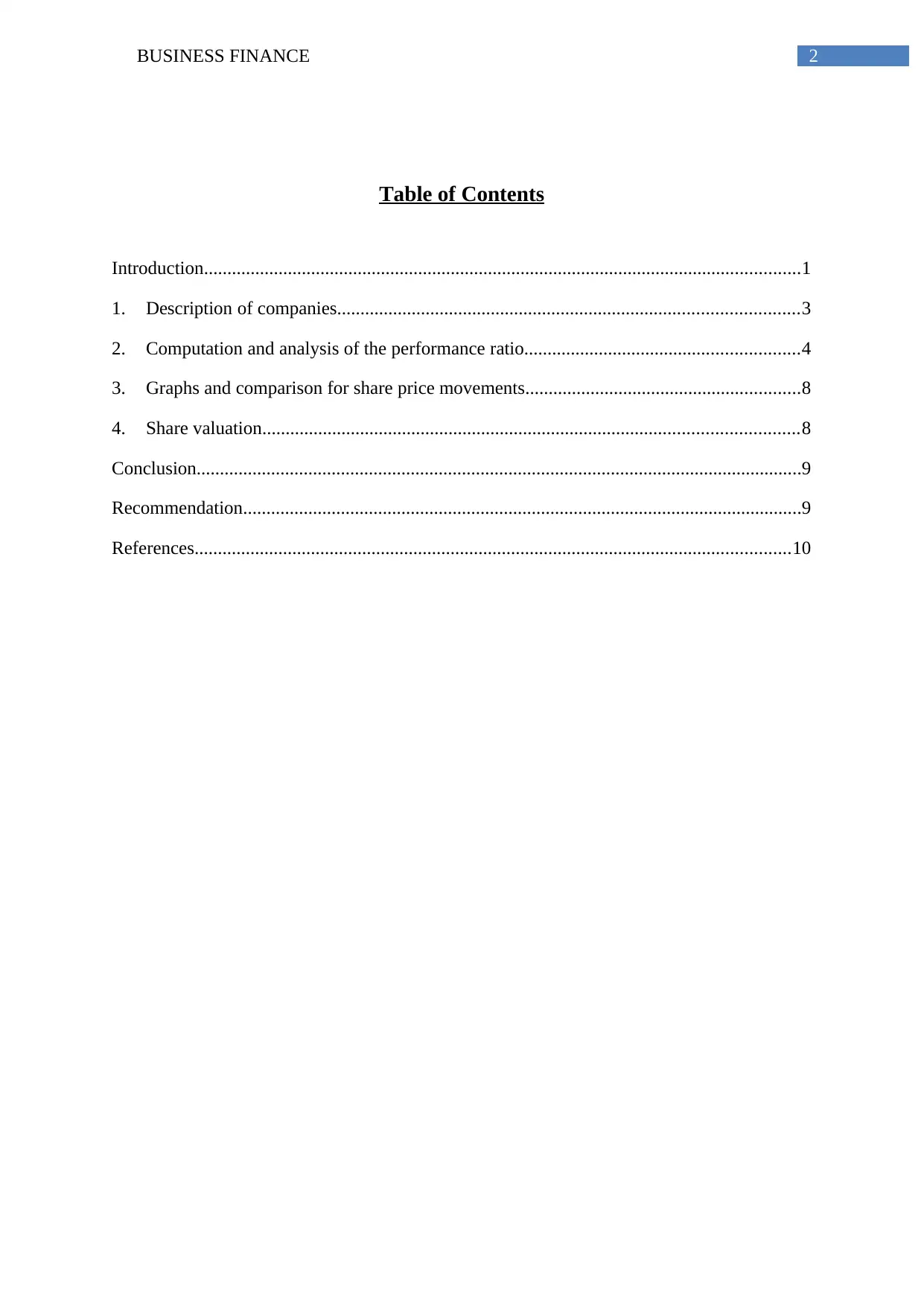
2BUSINESS FINANCE
Table of Contents
Introduction................................................................................................................................1
1. Description of companies...................................................................................................3
2. Computation and analysis of the performance ratio...........................................................4
3. Graphs and comparison for share price movements...........................................................8
4. Share valuation...................................................................................................................8
Conclusion..................................................................................................................................9
Recommendation........................................................................................................................9
References................................................................................................................................10
Table of Contents
Introduction................................................................................................................................1
1. Description of companies...................................................................................................3
2. Computation and analysis of the performance ratio...........................................................4
3. Graphs and comparison for share price movements...........................................................8
4. Share valuation...................................................................................................................8
Conclusion..................................................................................................................................9
Recommendation........................................................................................................................9
References................................................................................................................................10
⊘ This is a preview!⊘
Do you want full access?
Subscribe today to unlock all pages.

Trusted by 1+ million students worldwide
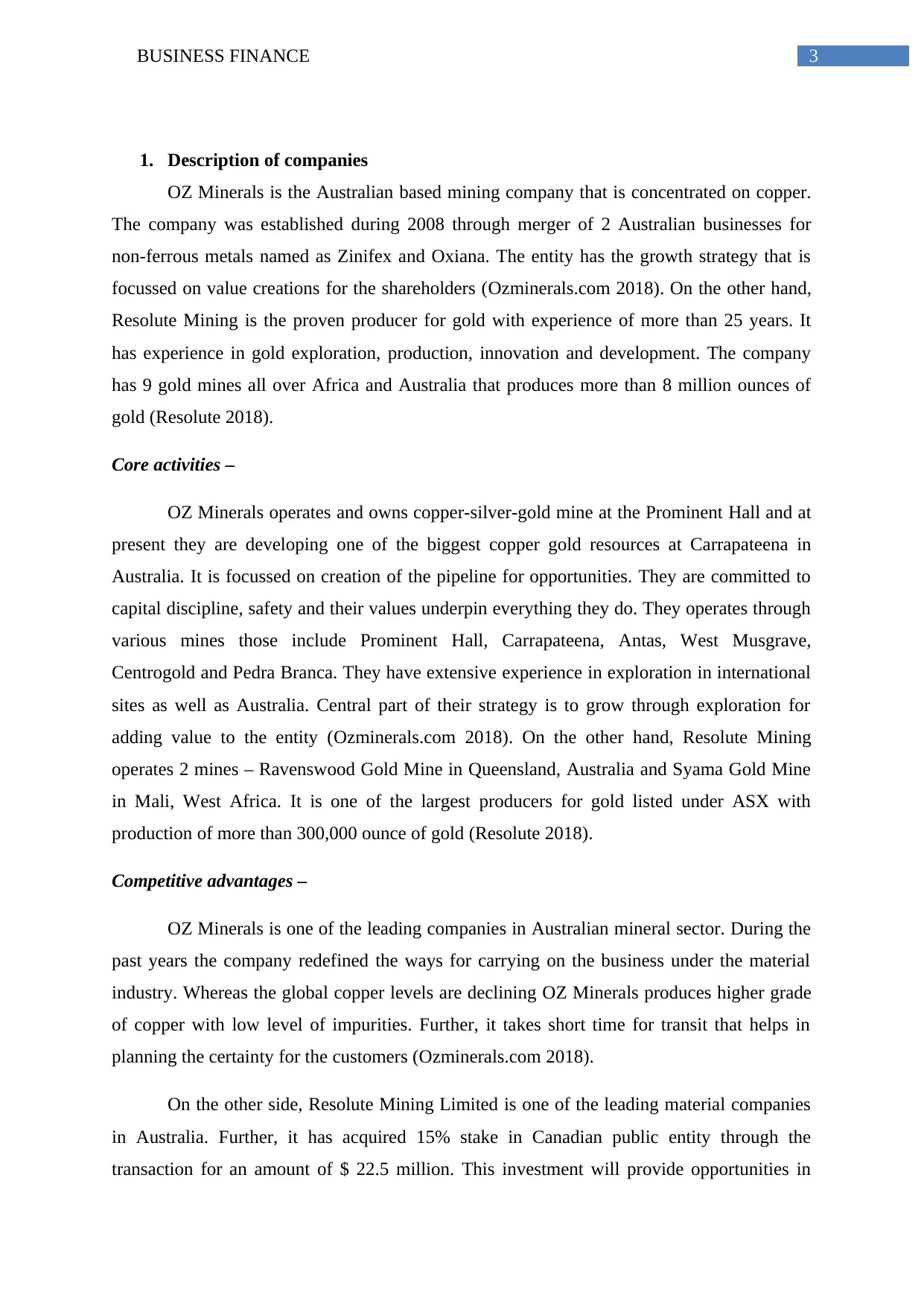
3BUSINESS FINANCE
1. Description of companies
OZ Minerals is the Australian based mining company that is concentrated on copper.
The company was established during 2008 through merger of 2 Australian businesses for
non-ferrous metals named as Zinifex and Oxiana. The entity has the growth strategy that is
focussed on value creations for the shareholders (Ozminerals.com 2018). On the other hand,
Resolute Mining is the proven producer for gold with experience of more than 25 years. It
has experience in gold exploration, production, innovation and development. The company
has 9 gold mines all over Africa and Australia that produces more than 8 million ounces of
gold (Resolute 2018).
Core activities –
OZ Minerals operates and owns copper-silver-gold mine at the Prominent Hall and at
present they are developing one of the biggest copper gold resources at Carrapateena in
Australia. It is focussed on creation of the pipeline for opportunities. They are committed to
capital discipline, safety and their values underpin everything they do. They operates through
various mines those include Prominent Hall, Carrapateena, Antas, West Musgrave,
Centrogold and Pedra Branca. They have extensive experience in exploration in international
sites as well as Australia. Central part of their strategy is to grow through exploration for
adding value to the entity (Ozminerals.com 2018). On the other hand, Resolute Mining
operates 2 mines – Ravenswood Gold Mine in Queensland, Australia and Syama Gold Mine
in Mali, West Africa. It is one of the largest producers for gold listed under ASX with
production of more than 300,000 ounce of gold (Resolute 2018).
Competitive advantages –
OZ Minerals is one of the leading companies in Australian mineral sector. During the
past years the company redefined the ways for carrying on the business under the material
industry. Whereas the global copper levels are declining OZ Minerals produces higher grade
of copper with low level of impurities. Further, it takes short time for transit that helps in
planning the certainty for the customers (Ozminerals.com 2018).
On the other side, Resolute Mining Limited is one of the leading material companies
in Australia. Further, it has acquired 15% stake in Canadian public entity through the
transaction for an amount of $ 22.5 million. This investment will provide opportunities in
1. Description of companies
OZ Minerals is the Australian based mining company that is concentrated on copper.
The company was established during 2008 through merger of 2 Australian businesses for
non-ferrous metals named as Zinifex and Oxiana. The entity has the growth strategy that is
focussed on value creations for the shareholders (Ozminerals.com 2018). On the other hand,
Resolute Mining is the proven producer for gold with experience of more than 25 years. It
has experience in gold exploration, production, innovation and development. The company
has 9 gold mines all over Africa and Australia that produces more than 8 million ounces of
gold (Resolute 2018).
Core activities –
OZ Minerals operates and owns copper-silver-gold mine at the Prominent Hall and at
present they are developing one of the biggest copper gold resources at Carrapateena in
Australia. It is focussed on creation of the pipeline for opportunities. They are committed to
capital discipline, safety and their values underpin everything they do. They operates through
various mines those include Prominent Hall, Carrapateena, Antas, West Musgrave,
Centrogold and Pedra Branca. They have extensive experience in exploration in international
sites as well as Australia. Central part of their strategy is to grow through exploration for
adding value to the entity (Ozminerals.com 2018). On the other hand, Resolute Mining
operates 2 mines – Ravenswood Gold Mine in Queensland, Australia and Syama Gold Mine
in Mali, West Africa. It is one of the largest producers for gold listed under ASX with
production of more than 300,000 ounce of gold (Resolute 2018).
Competitive advantages –
OZ Minerals is one of the leading companies in Australian mineral sector. During the
past years the company redefined the ways for carrying on the business under the material
industry. Whereas the global copper levels are declining OZ Minerals produces higher grade
of copper with low level of impurities. Further, it takes short time for transit that helps in
planning the certainty for the customers (Ozminerals.com 2018).
On the other side, Resolute Mining Limited is one of the leading material companies
in Australia. Further, it has acquired 15% stake in Canadian public entity through the
transaction for an amount of $ 22.5 million. This investment will provide opportunities in
Paraphrase This Document
Need a fresh take? Get an instant paraphrase of this document with our AI Paraphraser

4BUSINESS FINANCE
Cote D’Ivoire, Sudan and other places of Africa. Further, it added to the investment portfolio
of the company including the Oklo Resources, Mako Gold and Loncor Resources (Resolute
2018).
Historical consideration –
OZ minerals had been awarded with the development of Carrapateena underground
mine that is valued at $ 660 million. Review of the contract for underground mining is
aligned with beginning of Carrapateena mine’s development that will be started after
receiving primary approval including Mining lease from State and Federal Governments.
Under this contract work scope for the company includes – (i) sire development and set up to
top of ore infrastructure and body excavation (ii) production ramp up and set up and (iii)
bedding under steady-state operations at the capacity of nameplate site (Ozminerals.com
2018).
Resolute Mining completed the strategic investment in Loncor Resources Inc and
Orca Gold Mine. It also acquired additional 3% holding in Manas Resources Limited through
the agreement of share swap. It resulted into issuance of new shares amounting to 11.28
million (Resolute 2018).
2. Computation and analysis of the performance ratio
Ratio Formula OZ Minerals Resolute Mining
2017 2016 2017 2016
Short-term solvency
Current ratio Current assets/current
liabilities 5.06 5.40 4.07 2.98
Quick ratio (Current assets-inventories)
/ Current liabilities 3.88 4.25 2.42 1.01
Long term solvency
Debt equity ratio Total liabilities/
shareholder's equity 0.12 0.12 0.29 0.45
Debt ratio Total liabilities / Total
assets 0.11 0.11 0.23 0.31
Asset utilization ratio
Asset turnover ratio Net sales/total assets 0.36 0.31 0.65 1.13
Return on assets NPAT / Total asset 0.08 0.04 0.20 0.32
Profitability ratio
Interest coverage ratio EBIT/interest expense 84.39 26.50 50.91 18.17
Net profit ratio Net profit/net sales *100 22.59 13.10 30.69 36.19
Market value ratio
Cote D’Ivoire, Sudan and other places of Africa. Further, it added to the investment portfolio
of the company including the Oklo Resources, Mako Gold and Loncor Resources (Resolute
2018).
Historical consideration –
OZ minerals had been awarded with the development of Carrapateena underground
mine that is valued at $ 660 million. Review of the contract for underground mining is
aligned with beginning of Carrapateena mine’s development that will be started after
receiving primary approval including Mining lease from State and Federal Governments.
Under this contract work scope for the company includes – (i) sire development and set up to
top of ore infrastructure and body excavation (ii) production ramp up and set up and (iii)
bedding under steady-state operations at the capacity of nameplate site (Ozminerals.com
2018).
Resolute Mining completed the strategic investment in Loncor Resources Inc and
Orca Gold Mine. It also acquired additional 3% holding in Manas Resources Limited through
the agreement of share swap. It resulted into issuance of new shares amounting to 11.28
million (Resolute 2018).
2. Computation and analysis of the performance ratio
Ratio Formula OZ Minerals Resolute Mining
2017 2016 2017 2016
Short-term solvency
Current ratio Current assets/current
liabilities 5.06 5.40 4.07 2.98
Quick ratio (Current assets-inventories)
/ Current liabilities 3.88 4.25 2.42 1.01
Long term solvency
Debt equity ratio Total liabilities/
shareholder's equity 0.12 0.12 0.29 0.45
Debt ratio Total liabilities / Total
assets 0.11 0.11 0.23 0.31
Asset utilization ratio
Asset turnover ratio Net sales/total assets 0.36 0.31 0.65 1.13
Return on assets NPAT / Total asset 0.08 0.04 0.20 0.32
Profitability ratio
Interest coverage ratio EBIT/interest expense 84.39 26.50 50.91 18.17
Net profit ratio Net profit/net sales *100 22.59 13.10 30.69 36.19
Market value ratio
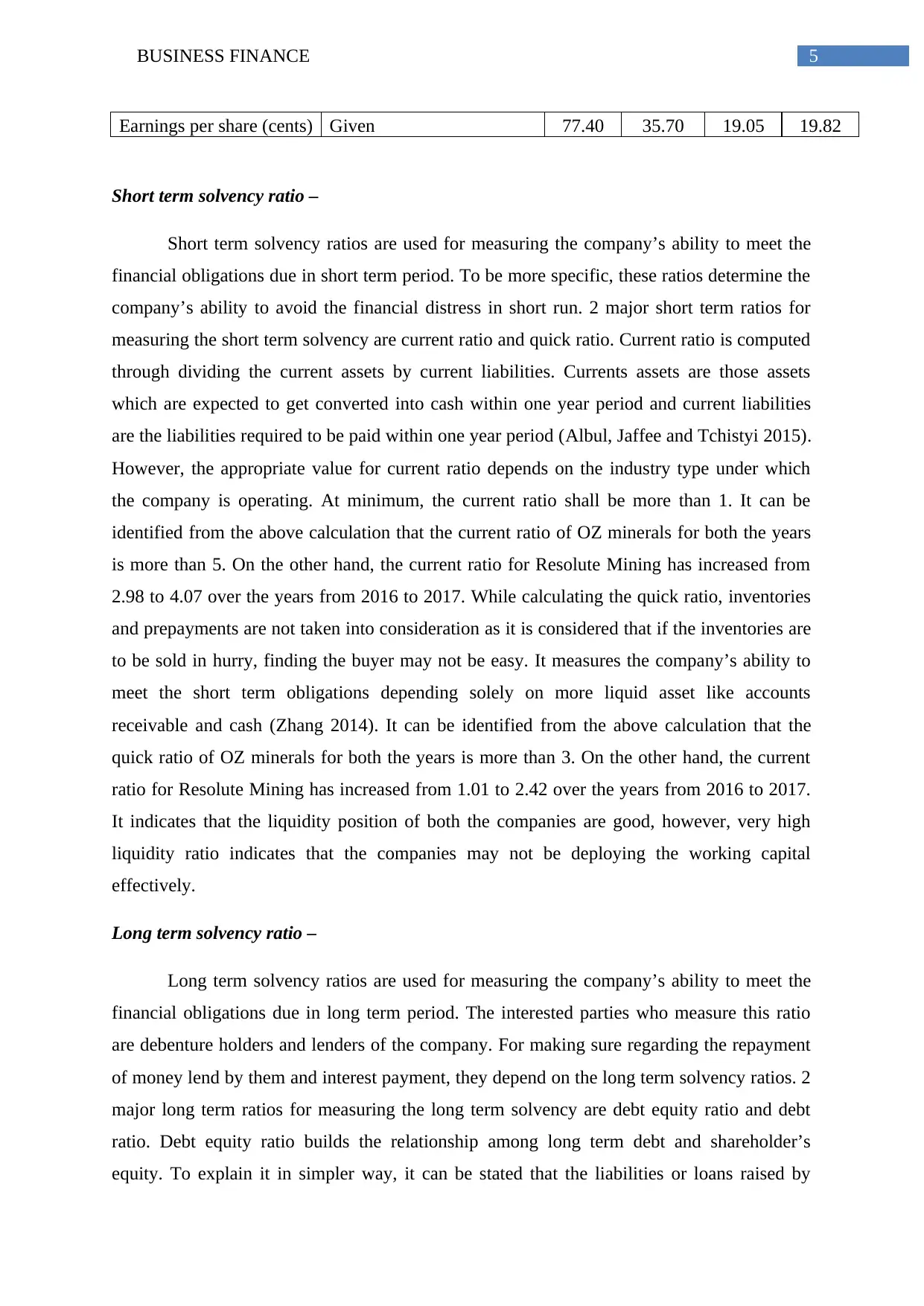
5BUSINESS FINANCE
Earnings per share (cents) Given 77.40 35.70 19.05 19.82
Short term solvency ratio –
Short term solvency ratios are used for measuring the company’s ability to meet the
financial obligations due in short term period. To be more specific, these ratios determine the
company’s ability to avoid the financial distress in short run. 2 major short term ratios for
measuring the short term solvency are current ratio and quick ratio. Current ratio is computed
through dividing the current assets by current liabilities. Currents assets are those assets
which are expected to get converted into cash within one year period and current liabilities
are the liabilities required to be paid within one year period (Albul, Jaffee and Tchistyi 2015).
However, the appropriate value for current ratio depends on the industry type under which
the company is operating. At minimum, the current ratio shall be more than 1. It can be
identified from the above calculation that the current ratio of OZ minerals for both the years
is more than 5. On the other hand, the current ratio for Resolute Mining has increased from
2.98 to 4.07 over the years from 2016 to 2017. While calculating the quick ratio, inventories
and prepayments are not taken into consideration as it is considered that if the inventories are
to be sold in hurry, finding the buyer may not be easy. It measures the company’s ability to
meet the short term obligations depending solely on more liquid asset like accounts
receivable and cash (Zhang 2014). It can be identified from the above calculation that the
quick ratio of OZ minerals for both the years is more than 3. On the other hand, the current
ratio for Resolute Mining has increased from 1.01 to 2.42 over the years from 2016 to 2017.
It indicates that the liquidity position of both the companies are good, however, very high
liquidity ratio indicates that the companies may not be deploying the working capital
effectively.
Long term solvency ratio –
Long term solvency ratios are used for measuring the company’s ability to meet the
financial obligations due in long term period. The interested parties who measure this ratio
are debenture holders and lenders of the company. For making sure regarding the repayment
of money lend by them and interest payment, they depend on the long term solvency ratios. 2
major long term ratios for measuring the long term solvency are debt equity ratio and debt
ratio. Debt equity ratio builds the relationship among long term debt and shareholder’s
equity. To explain it in simpler way, it can be stated that the liabilities or loans raised by
Earnings per share (cents) Given 77.40 35.70 19.05 19.82
Short term solvency ratio –
Short term solvency ratios are used for measuring the company’s ability to meet the
financial obligations due in short term period. To be more specific, these ratios determine the
company’s ability to avoid the financial distress in short run. 2 major short term ratios for
measuring the short term solvency are current ratio and quick ratio. Current ratio is computed
through dividing the current assets by current liabilities. Currents assets are those assets
which are expected to get converted into cash within one year period and current liabilities
are the liabilities required to be paid within one year period (Albul, Jaffee and Tchistyi 2015).
However, the appropriate value for current ratio depends on the industry type under which
the company is operating. At minimum, the current ratio shall be more than 1. It can be
identified from the above calculation that the current ratio of OZ minerals for both the years
is more than 5. On the other hand, the current ratio for Resolute Mining has increased from
2.98 to 4.07 over the years from 2016 to 2017. While calculating the quick ratio, inventories
and prepayments are not taken into consideration as it is considered that if the inventories are
to be sold in hurry, finding the buyer may not be easy. It measures the company’s ability to
meet the short term obligations depending solely on more liquid asset like accounts
receivable and cash (Zhang 2014). It can be identified from the above calculation that the
quick ratio of OZ minerals for both the years is more than 3. On the other hand, the current
ratio for Resolute Mining has increased from 1.01 to 2.42 over the years from 2016 to 2017.
It indicates that the liquidity position of both the companies are good, however, very high
liquidity ratio indicates that the companies may not be deploying the working capital
effectively.
Long term solvency ratio –
Long term solvency ratios are used for measuring the company’s ability to meet the
financial obligations due in long term period. The interested parties who measure this ratio
are debenture holders and lenders of the company. For making sure regarding the repayment
of money lend by them and interest payment, they depend on the long term solvency ratios. 2
major long term ratios for measuring the long term solvency are debt equity ratio and debt
ratio. Debt equity ratio builds the relationship among long term debt and shareholder’s
equity. To explain it in simpler way, it can be stated that the liabilities or loans raised by
⊘ This is a preview!⊘
Do you want full access?
Subscribe today to unlock all pages.

Trusted by 1+ million students worldwide
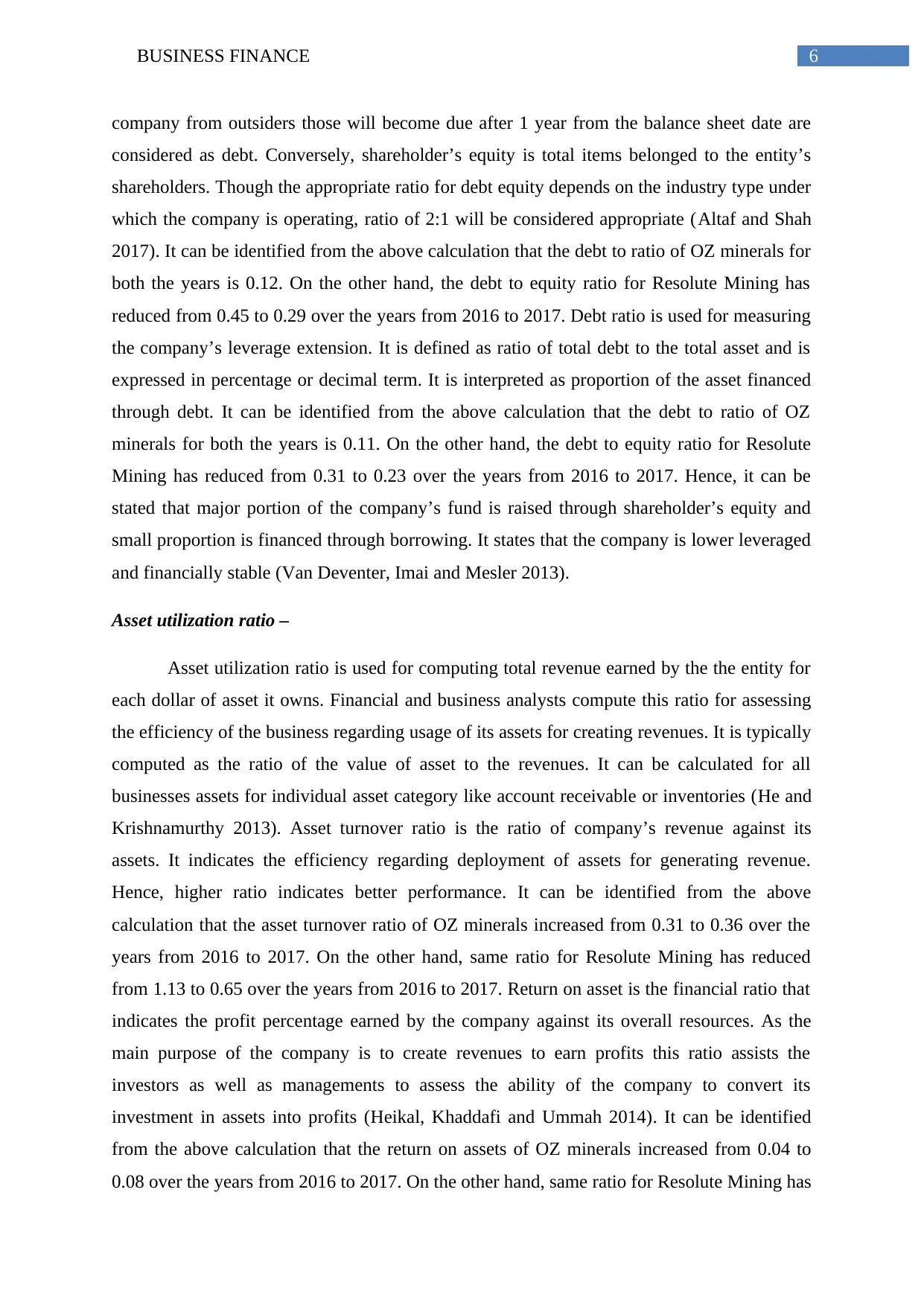
6BUSINESS FINANCE
company from outsiders those will become due after 1 year from the balance sheet date are
considered as debt. Conversely, shareholder’s equity is total items belonged to the entity’s
shareholders. Though the appropriate ratio for debt equity depends on the industry type under
which the company is operating, ratio of 2:1 will be considered appropriate (Altaf and Shah
2017). It can be identified from the above calculation that the debt to ratio of OZ minerals for
both the years is 0.12. On the other hand, the debt to equity ratio for Resolute Mining has
reduced from 0.45 to 0.29 over the years from 2016 to 2017. Debt ratio is used for measuring
the company’s leverage extension. It is defined as ratio of total debt to the total asset and is
expressed in percentage or decimal term. It is interpreted as proportion of the asset financed
through debt. It can be identified from the above calculation that the debt to ratio of OZ
minerals for both the years is 0.11. On the other hand, the debt to equity ratio for Resolute
Mining has reduced from 0.31 to 0.23 over the years from 2016 to 2017. Hence, it can be
stated that major portion of the company’s fund is raised through shareholder’s equity and
small proportion is financed through borrowing. It states that the company is lower leveraged
and financially stable (Van Deventer, Imai and Mesler 2013).
Asset utilization ratio –
Asset utilization ratio is used for computing total revenue earned by the the entity for
each dollar of asset it owns. Financial and business analysts compute this ratio for assessing
the efficiency of the business regarding usage of its assets for creating revenues. It is typically
computed as the ratio of the value of asset to the revenues. It can be calculated for all
businesses assets for individual asset category like account receivable or inventories (He and
Krishnamurthy 2013). Asset turnover ratio is the ratio of company’s revenue against its
assets. It indicates the efficiency regarding deployment of assets for generating revenue.
Hence, higher ratio indicates better performance. It can be identified from the above
calculation that the asset turnover ratio of OZ minerals increased from 0.31 to 0.36 over the
years from 2016 to 2017. On the other hand, same ratio for Resolute Mining has reduced
from 1.13 to 0.65 over the years from 2016 to 2017. Return on asset is the financial ratio that
indicates the profit percentage earned by the company against its overall resources. As the
main purpose of the company is to create revenues to earn profits this ratio assists the
investors as well as managements to assess the ability of the company to convert its
investment in assets into profits (Heikal, Khaddafi and Ummah 2014). It can be identified
from the above calculation that the return on assets of OZ minerals increased from 0.04 to
0.08 over the years from 2016 to 2017. On the other hand, same ratio for Resolute Mining has
company from outsiders those will become due after 1 year from the balance sheet date are
considered as debt. Conversely, shareholder’s equity is total items belonged to the entity’s
shareholders. Though the appropriate ratio for debt equity depends on the industry type under
which the company is operating, ratio of 2:1 will be considered appropriate (Altaf and Shah
2017). It can be identified from the above calculation that the debt to ratio of OZ minerals for
both the years is 0.12. On the other hand, the debt to equity ratio for Resolute Mining has
reduced from 0.45 to 0.29 over the years from 2016 to 2017. Debt ratio is used for measuring
the company’s leverage extension. It is defined as ratio of total debt to the total asset and is
expressed in percentage or decimal term. It is interpreted as proportion of the asset financed
through debt. It can be identified from the above calculation that the debt to ratio of OZ
minerals for both the years is 0.11. On the other hand, the debt to equity ratio for Resolute
Mining has reduced from 0.31 to 0.23 over the years from 2016 to 2017. Hence, it can be
stated that major portion of the company’s fund is raised through shareholder’s equity and
small proportion is financed through borrowing. It states that the company is lower leveraged
and financially stable (Van Deventer, Imai and Mesler 2013).
Asset utilization ratio –
Asset utilization ratio is used for computing total revenue earned by the the entity for
each dollar of asset it owns. Financial and business analysts compute this ratio for assessing
the efficiency of the business regarding usage of its assets for creating revenues. It is typically
computed as the ratio of the value of asset to the revenues. It can be calculated for all
businesses assets for individual asset category like account receivable or inventories (He and
Krishnamurthy 2013). Asset turnover ratio is the ratio of company’s revenue against its
assets. It indicates the efficiency regarding deployment of assets for generating revenue.
Hence, higher ratio indicates better performance. It can be identified from the above
calculation that the asset turnover ratio of OZ minerals increased from 0.31 to 0.36 over the
years from 2016 to 2017. On the other hand, same ratio for Resolute Mining has reduced
from 1.13 to 0.65 over the years from 2016 to 2017. Return on asset is the financial ratio that
indicates the profit percentage earned by the company against its overall resources. As the
main purpose of the company is to create revenues to earn profits this ratio assists the
investors as well as managements to assess the ability of the company to convert its
investment in assets into profits (Heikal, Khaddafi and Ummah 2014). It can be identified
from the above calculation that the return on assets of OZ minerals increased from 0.04 to
0.08 over the years from 2016 to 2017. On the other hand, same ratio for Resolute Mining has
Paraphrase This Document
Need a fresh take? Get an instant paraphrase of this document with our AI Paraphraser
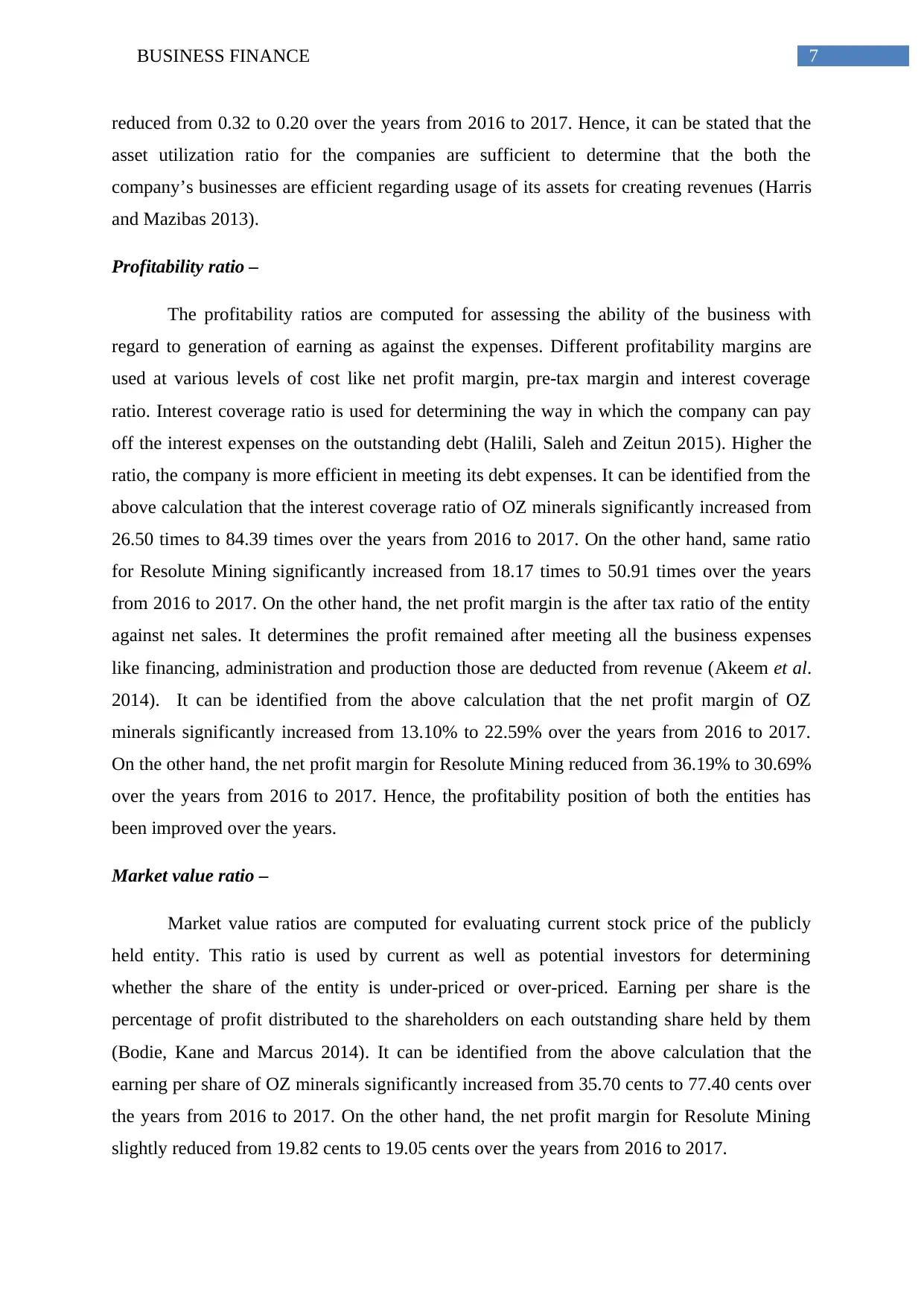
7BUSINESS FINANCE
reduced from 0.32 to 0.20 over the years from 2016 to 2017. Hence, it can be stated that the
asset utilization ratio for the companies are sufficient to determine that the both the
company’s businesses are efficient regarding usage of its assets for creating revenues (Harris
and Mazibas 2013).
Profitability ratio –
The profitability ratios are computed for assessing the ability of the business with
regard to generation of earning as against the expenses. Different profitability margins are
used at various levels of cost like net profit margin, pre-tax margin and interest coverage
ratio. Interest coverage ratio is used for determining the way in which the company can pay
off the interest expenses on the outstanding debt (Halili, Saleh and Zeitun 2015). Higher the
ratio, the company is more efficient in meeting its debt expenses. It can be identified from the
above calculation that the interest coverage ratio of OZ minerals significantly increased from
26.50 times to 84.39 times over the years from 2016 to 2017. On the other hand, same ratio
for Resolute Mining significantly increased from 18.17 times to 50.91 times over the years
from 2016 to 2017. On the other hand, the net profit margin is the after tax ratio of the entity
against net sales. It determines the profit remained after meeting all the business expenses
like financing, administration and production those are deducted from revenue (Akeem et al.
2014). It can be identified from the above calculation that the net profit margin of OZ
minerals significantly increased from 13.10% to 22.59% over the years from 2016 to 2017.
On the other hand, the net profit margin for Resolute Mining reduced from 36.19% to 30.69%
over the years from 2016 to 2017. Hence, the profitability position of both the entities has
been improved over the years.
Market value ratio –
Market value ratios are computed for evaluating current stock price of the publicly
held entity. This ratio is used by current as well as potential investors for determining
whether the share of the entity is under-priced or over-priced. Earning per share is the
percentage of profit distributed to the shareholders on each outstanding share held by them
(Bodie, Kane and Marcus 2014). It can be identified from the above calculation that the
earning per share of OZ minerals significantly increased from 35.70 cents to 77.40 cents over
the years from 2016 to 2017. On the other hand, the net profit margin for Resolute Mining
slightly reduced from 19.82 cents to 19.05 cents over the years from 2016 to 2017.
reduced from 0.32 to 0.20 over the years from 2016 to 2017. Hence, it can be stated that the
asset utilization ratio for the companies are sufficient to determine that the both the
company’s businesses are efficient regarding usage of its assets for creating revenues (Harris
and Mazibas 2013).
Profitability ratio –
The profitability ratios are computed for assessing the ability of the business with
regard to generation of earning as against the expenses. Different profitability margins are
used at various levels of cost like net profit margin, pre-tax margin and interest coverage
ratio. Interest coverage ratio is used for determining the way in which the company can pay
off the interest expenses on the outstanding debt (Halili, Saleh and Zeitun 2015). Higher the
ratio, the company is more efficient in meeting its debt expenses. It can be identified from the
above calculation that the interest coverage ratio of OZ minerals significantly increased from
26.50 times to 84.39 times over the years from 2016 to 2017. On the other hand, same ratio
for Resolute Mining significantly increased from 18.17 times to 50.91 times over the years
from 2016 to 2017. On the other hand, the net profit margin is the after tax ratio of the entity
against net sales. It determines the profit remained after meeting all the business expenses
like financing, administration and production those are deducted from revenue (Akeem et al.
2014). It can be identified from the above calculation that the net profit margin of OZ
minerals significantly increased from 13.10% to 22.59% over the years from 2016 to 2017.
On the other hand, the net profit margin for Resolute Mining reduced from 36.19% to 30.69%
over the years from 2016 to 2017. Hence, the profitability position of both the entities has
been improved over the years.
Market value ratio –
Market value ratios are computed for evaluating current stock price of the publicly
held entity. This ratio is used by current as well as potential investors for determining
whether the share of the entity is under-priced or over-priced. Earning per share is the
percentage of profit distributed to the shareholders on each outstanding share held by them
(Bodie, Kane and Marcus 2014). It can be identified from the above calculation that the
earning per share of OZ minerals significantly increased from 35.70 cents to 77.40 cents over
the years from 2016 to 2017. On the other hand, the net profit margin for Resolute Mining
slightly reduced from 19.82 cents to 19.05 cents over the years from 2016 to 2017.
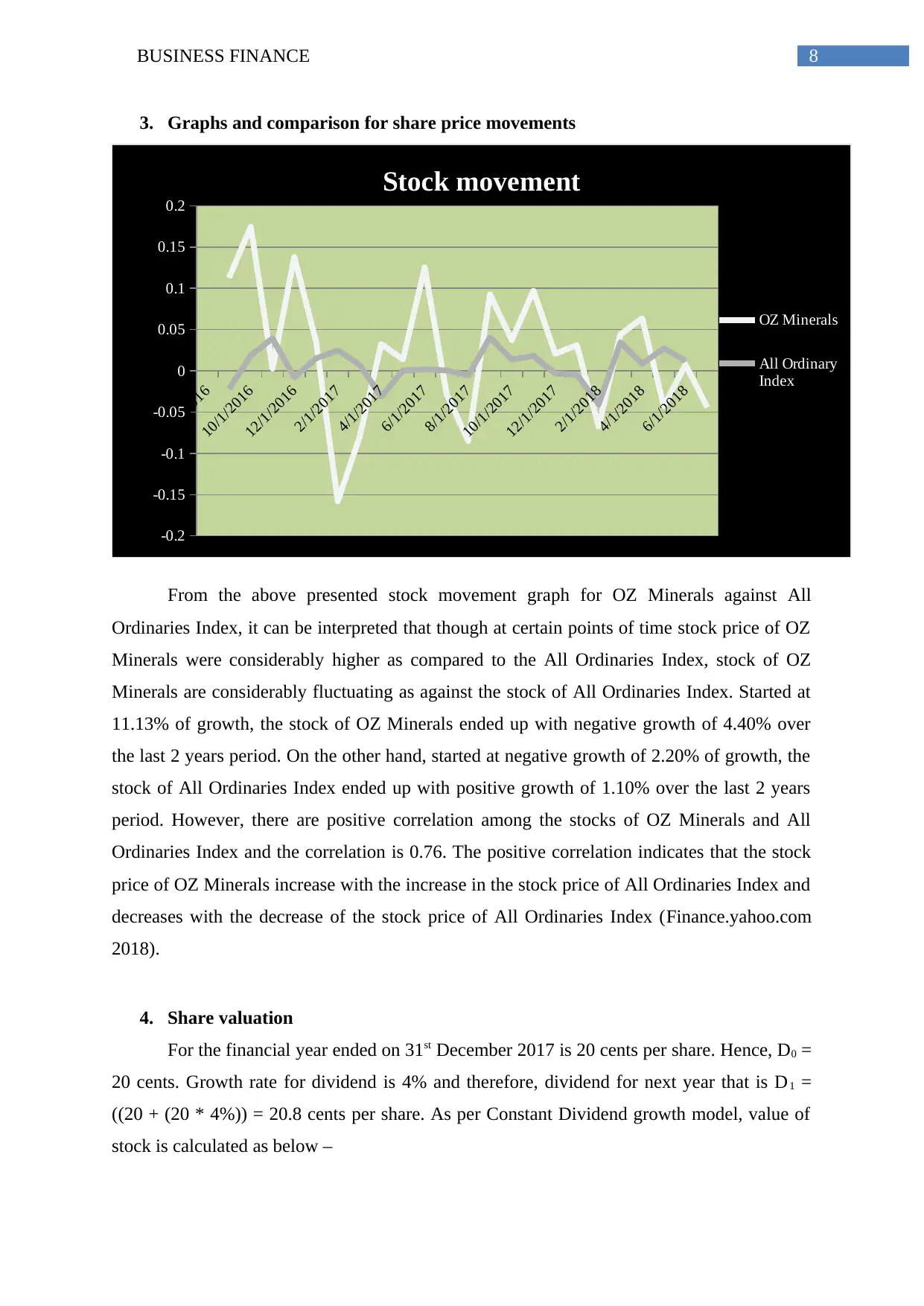
8BUSINESS FINANCE
3. Graphs and comparison for share price movements
8/1/2016
10/1/2016
12/1/2016
2/1/2017
4/1/2017
6/1/2017
8/1/2017
10/1/2017
12/1/2017
2/1/2018
4/1/2018
6/1/2018
-0.2
-0.15
-0.1
-0.05
0
0.05
0.1
0.15
0.2
Stock movement
OZ Minerals
All Ordinary
Index
From the above presented stock movement graph for OZ Minerals against All
Ordinaries Index, it can be interpreted that though at certain points of time stock price of OZ
Minerals were considerably higher as compared to the All Ordinaries Index, stock of OZ
Minerals are considerably fluctuating as against the stock of All Ordinaries Index. Started at
11.13% of growth, the stock of OZ Minerals ended up with negative growth of 4.40% over
the last 2 years period. On the other hand, started at negative growth of 2.20% of growth, the
stock of All Ordinaries Index ended up with positive growth of 1.10% over the last 2 years
period. However, there are positive correlation among the stocks of OZ Minerals and All
Ordinaries Index and the correlation is 0.76. The positive correlation indicates that the stock
price of OZ Minerals increase with the increase in the stock price of All Ordinaries Index and
decreases with the decrease of the stock price of All Ordinaries Index (Finance.yahoo.com
2018).
4. Share valuation
For the financial year ended on 31st December 2017 is 20 cents per share. Hence, D0 =
20 cents. Growth rate for dividend is 4% and therefore, dividend for next year that is D1 =
((20 + (20 * 4%)) = 20.8 cents per share. As per Constant Dividend growth model, value of
stock is calculated as below –
3. Graphs and comparison for share price movements
8/1/2016
10/1/2016
12/1/2016
2/1/2017
4/1/2017
6/1/2017
8/1/2017
10/1/2017
12/1/2017
2/1/2018
4/1/2018
6/1/2018
-0.2
-0.15
-0.1
-0.05
0
0.05
0.1
0.15
0.2
Stock movement
OZ Minerals
All Ordinary
Index
From the above presented stock movement graph for OZ Minerals against All
Ordinaries Index, it can be interpreted that though at certain points of time stock price of OZ
Minerals were considerably higher as compared to the All Ordinaries Index, stock of OZ
Minerals are considerably fluctuating as against the stock of All Ordinaries Index. Started at
11.13% of growth, the stock of OZ Minerals ended up with negative growth of 4.40% over
the last 2 years period. On the other hand, started at negative growth of 2.20% of growth, the
stock of All Ordinaries Index ended up with positive growth of 1.10% over the last 2 years
period. However, there are positive correlation among the stocks of OZ Minerals and All
Ordinaries Index and the correlation is 0.76. The positive correlation indicates that the stock
price of OZ Minerals increase with the increase in the stock price of All Ordinaries Index and
decreases with the decrease of the stock price of All Ordinaries Index (Finance.yahoo.com
2018).
4. Share valuation
For the financial year ended on 31st December 2017 is 20 cents per share. Hence, D0 =
20 cents. Growth rate for dividend is 4% and therefore, dividend for next year that is D1 =
((20 + (20 * 4%)) = 20.8 cents per share. As per Constant Dividend growth model, value of
stock is calculated as below –
⊘ This is a preview!⊘
Do you want full access?
Subscribe today to unlock all pages.

Trusted by 1+ million students worldwide
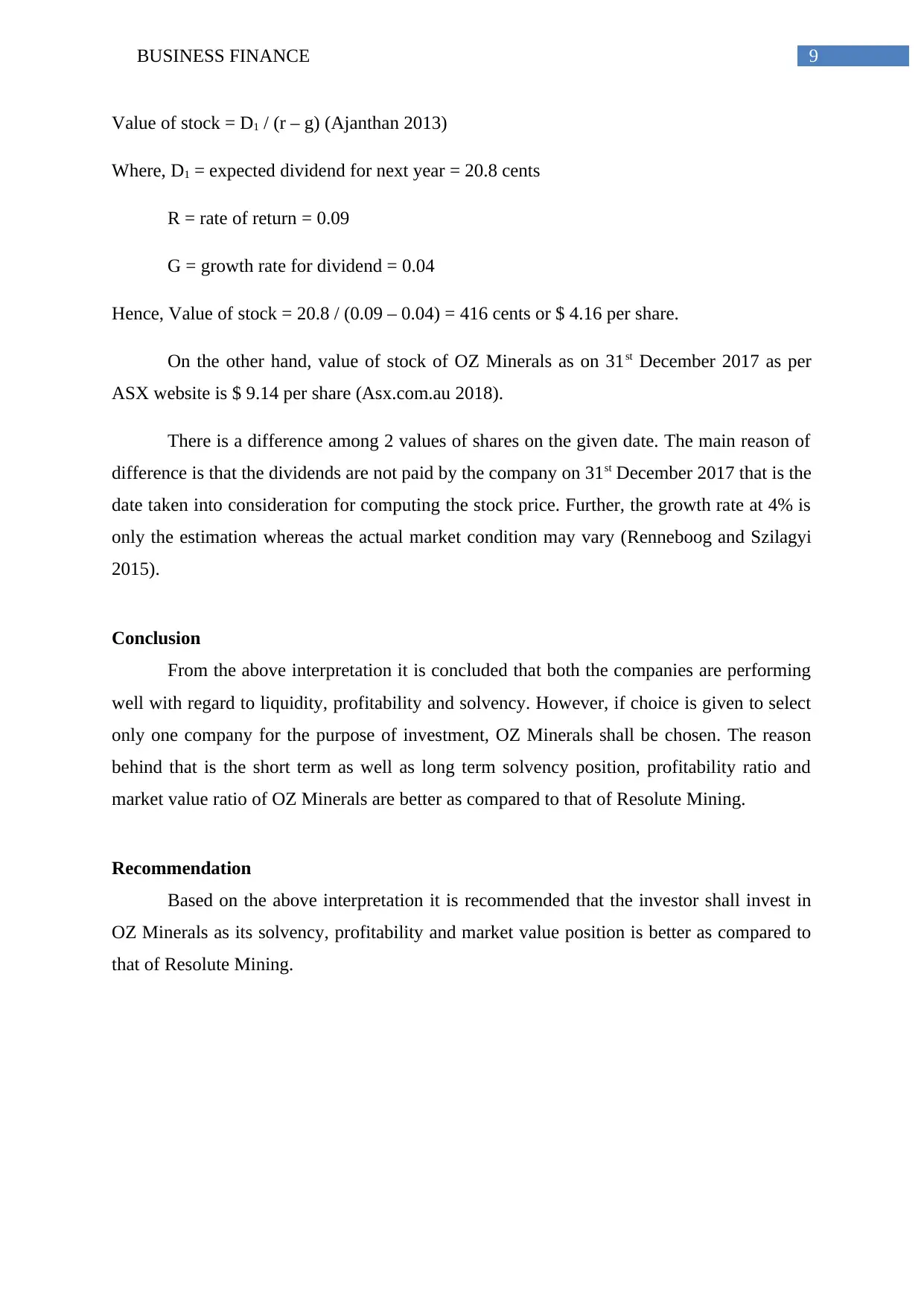
9BUSINESS FINANCE
Value of stock = D1 / (r – g) (Ajanthan 2013)
Where, D1 = expected dividend for next year = 20.8 cents
R = rate of return = 0.09
G = growth rate for dividend = 0.04
Hence, Value of stock = 20.8 / (0.09 – 0.04) = 416 cents or $ 4.16 per share.
On the other hand, value of stock of OZ Minerals as on 31st December 2017 as per
ASX website is $ 9.14 per share (Asx.com.au 2018).
There is a difference among 2 values of shares on the given date. The main reason of
difference is that the dividends are not paid by the company on 31st December 2017 that is the
date taken into consideration for computing the stock price. Further, the growth rate at 4% is
only the estimation whereas the actual market condition may vary (Renneboog and Szilagyi
2015).
Conclusion
From the above interpretation it is concluded that both the companies are performing
well with regard to liquidity, profitability and solvency. However, if choice is given to select
only one company for the purpose of investment, OZ Minerals shall be chosen. The reason
behind that is the short term as well as long term solvency position, profitability ratio and
market value ratio of OZ Minerals are better as compared to that of Resolute Mining.
Recommendation
Based on the above interpretation it is recommended that the investor shall invest in
OZ Minerals as its solvency, profitability and market value position is better as compared to
that of Resolute Mining.
Value of stock = D1 / (r – g) (Ajanthan 2013)
Where, D1 = expected dividend for next year = 20.8 cents
R = rate of return = 0.09
G = growth rate for dividend = 0.04
Hence, Value of stock = 20.8 / (0.09 – 0.04) = 416 cents or $ 4.16 per share.
On the other hand, value of stock of OZ Minerals as on 31st December 2017 as per
ASX website is $ 9.14 per share (Asx.com.au 2018).
There is a difference among 2 values of shares on the given date. The main reason of
difference is that the dividends are not paid by the company on 31st December 2017 that is the
date taken into consideration for computing the stock price. Further, the growth rate at 4% is
only the estimation whereas the actual market condition may vary (Renneboog and Szilagyi
2015).
Conclusion
From the above interpretation it is concluded that both the companies are performing
well with regard to liquidity, profitability and solvency. However, if choice is given to select
only one company for the purpose of investment, OZ Minerals shall be chosen. The reason
behind that is the short term as well as long term solvency position, profitability ratio and
market value ratio of OZ Minerals are better as compared to that of Resolute Mining.
Recommendation
Based on the above interpretation it is recommended that the investor shall invest in
OZ Minerals as its solvency, profitability and market value position is better as compared to
that of Resolute Mining.
Paraphrase This Document
Need a fresh take? Get an instant paraphrase of this document with our AI Paraphraser
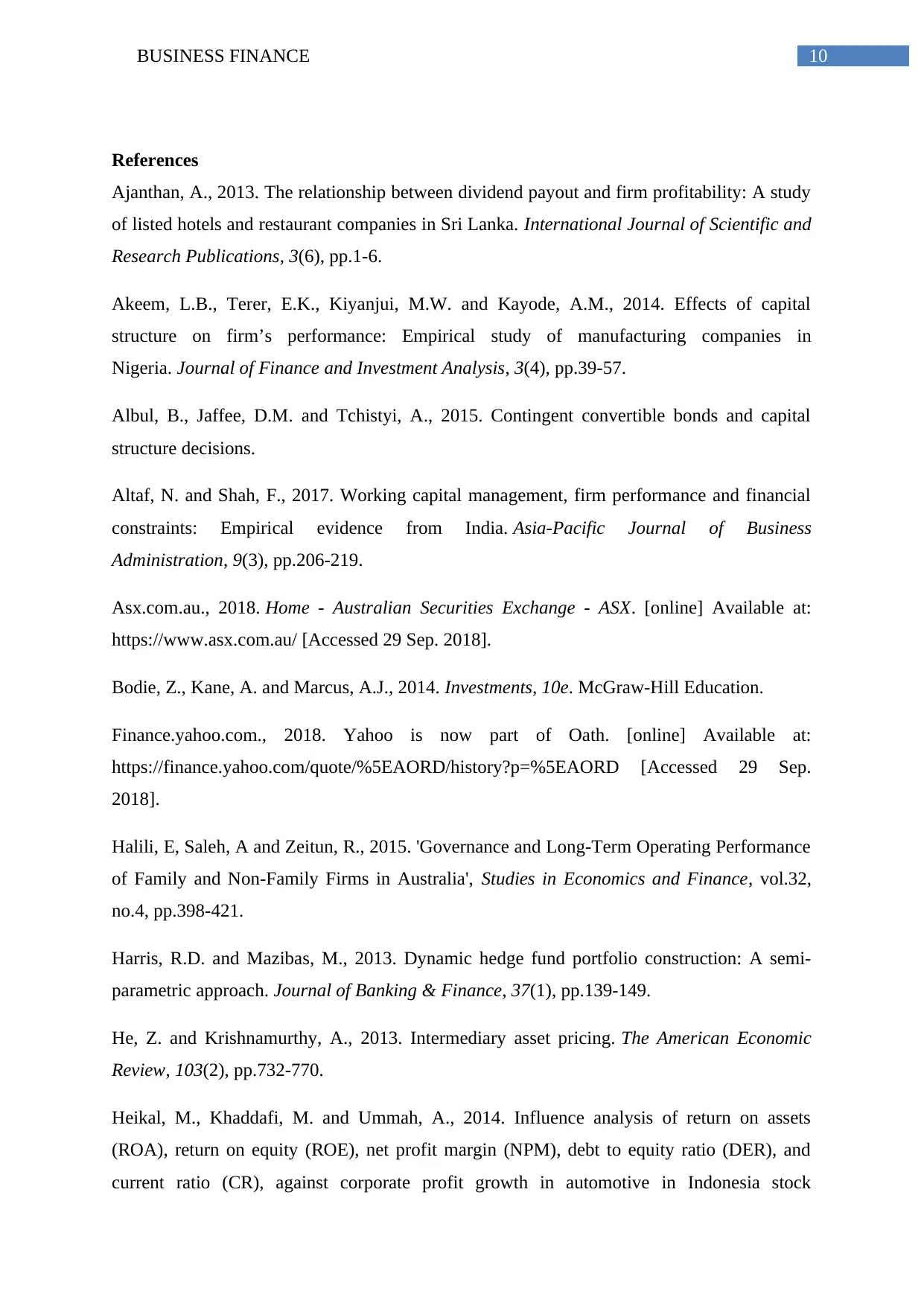
10BUSINESS FINANCE
References
Ajanthan, A., 2013. The relationship between dividend payout and firm profitability: A study
of listed hotels and restaurant companies in Sri Lanka. International Journal of Scientific and
Research Publications, 3(6), pp.1-6.
Akeem, L.B., Terer, E.K., Kiyanjui, M.W. and Kayode, A.M., 2014. Effects of capital
structure on firm’s performance: Empirical study of manufacturing companies in
Nigeria. Journal of Finance and Investment Analysis, 3(4), pp.39-57.
Albul, B., Jaffee, D.M. and Tchistyi, A., 2015. Contingent convertible bonds and capital
structure decisions.
Altaf, N. and Shah, F., 2017. Working capital management, firm performance and financial
constraints: Empirical evidence from India. Asia-Pacific Journal of Business
Administration, 9(3), pp.206-219.
Asx.com.au., 2018. Home - Australian Securities Exchange - ASX. [online] Available at:
https://www.asx.com.au/ [Accessed 29 Sep. 2018].
Bodie, Z., Kane, A. and Marcus, A.J., 2014. Investments, 10e. McGraw-Hill Education.
Finance.yahoo.com., 2018. Yahoo is now part of Oath. [online] Available at:
https://finance.yahoo.com/quote/%5EAORD/history?p=%5EAORD [Accessed 29 Sep.
2018].
Halili, E, Saleh, A and Zeitun, R., 2015. 'Governance and Long-Term Operating Performance
of Family and Non-Family Firms in Australia', Studies in Economics and Finance, vol.32,
no.4, pp.398-421.
Harris, R.D. and Mazibas, M., 2013. Dynamic hedge fund portfolio construction: A semi-
parametric approach. Journal of Banking & Finance, 37(1), pp.139-149.
He, Z. and Krishnamurthy, A., 2013. Intermediary asset pricing. The American Economic
Review, 103(2), pp.732-770.
Heikal, M., Khaddafi, M. and Ummah, A., 2014. Influence analysis of return on assets
(ROA), return on equity (ROE), net profit margin (NPM), debt to equity ratio (DER), and
current ratio (CR), against corporate profit growth in automotive in Indonesia stock
References
Ajanthan, A., 2013. The relationship between dividend payout and firm profitability: A study
of listed hotels and restaurant companies in Sri Lanka. International Journal of Scientific and
Research Publications, 3(6), pp.1-6.
Akeem, L.B., Terer, E.K., Kiyanjui, M.W. and Kayode, A.M., 2014. Effects of capital
structure on firm’s performance: Empirical study of manufacturing companies in
Nigeria. Journal of Finance and Investment Analysis, 3(4), pp.39-57.
Albul, B., Jaffee, D.M. and Tchistyi, A., 2015. Contingent convertible bonds and capital
structure decisions.
Altaf, N. and Shah, F., 2017. Working capital management, firm performance and financial
constraints: Empirical evidence from India. Asia-Pacific Journal of Business
Administration, 9(3), pp.206-219.
Asx.com.au., 2018. Home - Australian Securities Exchange - ASX. [online] Available at:
https://www.asx.com.au/ [Accessed 29 Sep. 2018].
Bodie, Z., Kane, A. and Marcus, A.J., 2014. Investments, 10e. McGraw-Hill Education.
Finance.yahoo.com., 2018. Yahoo is now part of Oath. [online] Available at:
https://finance.yahoo.com/quote/%5EAORD/history?p=%5EAORD [Accessed 29 Sep.
2018].
Halili, E, Saleh, A and Zeitun, R., 2015. 'Governance and Long-Term Operating Performance
of Family and Non-Family Firms in Australia', Studies in Economics and Finance, vol.32,
no.4, pp.398-421.
Harris, R.D. and Mazibas, M., 2013. Dynamic hedge fund portfolio construction: A semi-
parametric approach. Journal of Banking & Finance, 37(1), pp.139-149.
He, Z. and Krishnamurthy, A., 2013. Intermediary asset pricing. The American Economic
Review, 103(2), pp.732-770.
Heikal, M., Khaddafi, M. and Ummah, A., 2014. Influence analysis of return on assets
(ROA), return on equity (ROE), net profit margin (NPM), debt to equity ratio (DER), and
current ratio (CR), against corporate profit growth in automotive in Indonesia stock
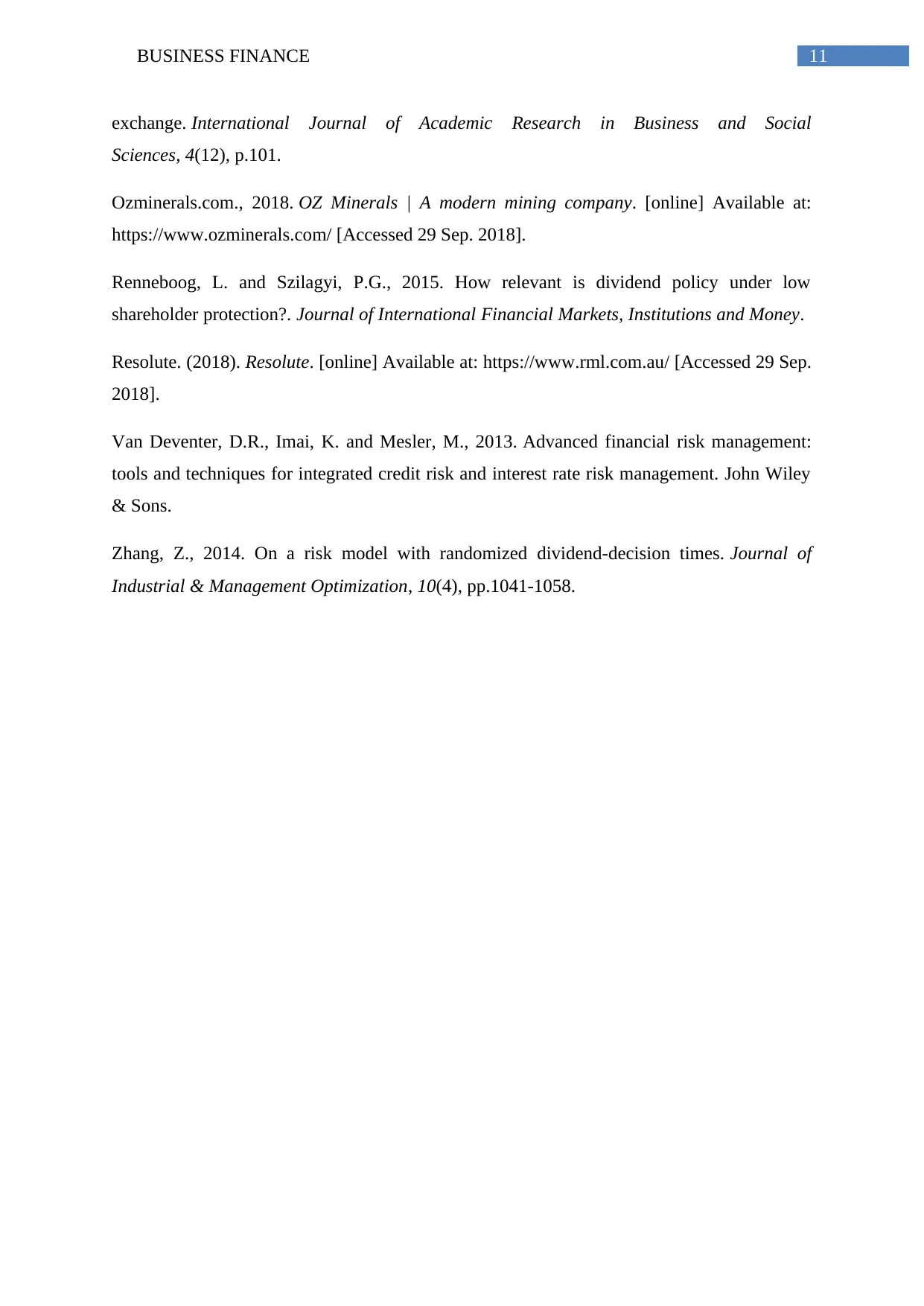
11BUSINESS FINANCE
exchange. International Journal of Academic Research in Business and Social
Sciences, 4(12), p.101.
Ozminerals.com., 2018. OZ Minerals | A modern mining company. [online] Available at:
https://www.ozminerals.com/ [Accessed 29 Sep. 2018].
Renneboog, L. and Szilagyi, P.G., 2015. How relevant is dividend policy under low
shareholder protection?. Journal of International Financial Markets, Institutions and Money.
Resolute. (2018). Resolute. [online] Available at: https://www.rml.com.au/ [Accessed 29 Sep.
2018].
Van Deventer, D.R., Imai, K. and Mesler, M., 2013. Advanced financial risk management:
tools and techniques for integrated credit risk and interest rate risk management. John Wiley
& Sons.
Zhang, Z., 2014. On a risk model with randomized dividend-decision times. Journal of
Industrial & Management Optimization, 10(4), pp.1041-1058.
exchange. International Journal of Academic Research in Business and Social
Sciences, 4(12), p.101.
Ozminerals.com., 2018. OZ Minerals | A modern mining company. [online] Available at:
https://www.ozminerals.com/ [Accessed 29 Sep. 2018].
Renneboog, L. and Szilagyi, P.G., 2015. How relevant is dividend policy under low
shareholder protection?. Journal of International Financial Markets, Institutions and Money.
Resolute. (2018). Resolute. [online] Available at: https://www.rml.com.au/ [Accessed 29 Sep.
2018].
Van Deventer, D.R., Imai, K. and Mesler, M., 2013. Advanced financial risk management:
tools and techniques for integrated credit risk and interest rate risk management. John Wiley
& Sons.
Zhang, Z., 2014. On a risk model with randomized dividend-decision times. Journal of
Industrial & Management Optimization, 10(4), pp.1041-1058.
⊘ This is a preview!⊘
Do you want full access?
Subscribe today to unlock all pages.

Trusted by 1+ million students worldwide
1 out of 12
Related Documents
Your All-in-One AI-Powered Toolkit for Academic Success.
+13062052269
info@desklib.com
Available 24*7 on WhatsApp / Email
![[object Object]](/_next/static/media/star-bottom.7253800d.svg)
Unlock your academic potential
Copyright © 2020–2025 A2Z Services. All Rights Reserved. Developed and managed by ZUCOL.





